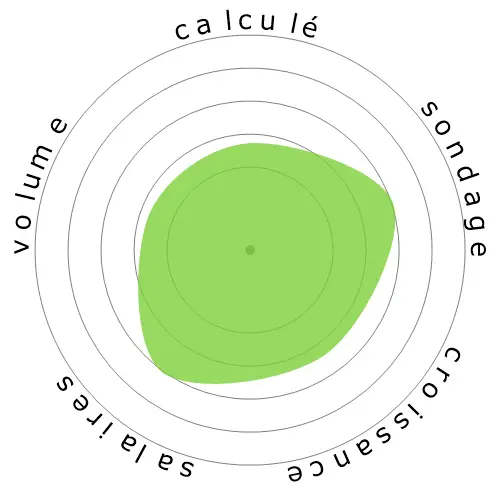Chimistes




Les gens ont également vu
Risque d'automatisation calculé
Risque Modéré (41-60%) : Les professions présentant un risque modéré d'automatisation impliquent généralement des tâches routinières mais nécessitent toujours un certain jugement et interaction humains.
Plus d'informations sur ce que représente ce score et comment il est calculé sont disponibles ici.
Sondage utilisateur
Nos visiteurs ont voté qu'il y a peu de chances que cette profession soit automatisée. Cette évaluation est davantage soutenue par le niveau de risque d'automatisation calculé, qui estime 46% de chances d'automatisation.
Que pensez-vous du risque de l'automatisation?
Quelle est la probabilité que Chimistes soit remplacé par des robots ou l'intelligence artificielle dans les 20 prochaines années ?
Sentiment
Le graphique suivant est inclus chaque fois qu'il y a un nombre substantiel de votes pour rendre les données significatives. Ces représentations visuelles affichent les résultats des sondages utilisateurs au fil du temps, fournissant une indication significative des tendances de sentiment.
Sentiment au fil du temps (annuellement)
Croissance
On s'attend à ce que le nombre de postes vacants pour 'Chemists' augmente 7,6% d'ici 2033
Emploi total, et estimations des offres d'emploi
Les prévisions mises à jour sont attendues 09-2025.
Salaires
En 2023, le salaire annuel médian pour 'Chemists' était de 84 680 $, soit 40 $ par heure.
'Chemists' ont été payés 76,2% de plus que le salaire médian national, qui était de 48 060 $
Salaires au fil du temps
Volume
À partir de 2023, il y avait 83 530 personnes employées en tant que 'Chemists' aux États-Unis.
Cela représente environ 0,06% de la main-d'œuvre employée à travers le pays
Autrement dit, environ 1 personne sur 1 mille est employée en tant que 'Chemists'.
Description du poste
Effectuez des analyses ou des expériences chimiques qualitatives et quantitatives dans les laboratoires pour le contrôle de la qualité ou du processus ou pour développer de nouveaux produits ou connaissances.
SOC Code: 19-2031.00


Commentaires
Leave a comment
There are autotitrators and autosamplers for many different equipment (Dissolution systems, HPLC, GC, UPLC, Mass spec and so on). These technologies have been around for decades yet analysts are still required to prepare samples, analyze them and then interpret and report data .
The two tenants which make a job susceptible to replacent by automation are Predictability and complexity. Some chemical analysis (more specifically wet chemistry, non-instrumental techniques) is more complex than what current automation systems can handle (i.e. chemical digestion of a sample, followed by extraction with a solvent, evaporation of the solvent) also sample quality is unpredictable (hence why QC labs exist, if every manufacturing method was flawless there would be no need for QC/QA).
Aspects of Inorganic Chemistry, Physical Organic Chemistry, and Polymers (as a part of Organic Chemistry) are very relevant to developing new materials with desirable properties. In fact, the Bureau of Labor Statistics (BLS) in the U.S.A. categorizes Chemists and Material Scientists as one and the same profile.
Job opportunities for Material Scientists do allow Chemists to be considered as Material Scientists when the Chemist has experience and multiple credits in Physical Chemistry, Polymers, and/or Inorganic Chemistry. Many Chemists follow this professional direction. In fact, some departments are even named 'Materials Chemistry'.
This fact indicates that one of these professions has an incorrect percentage representation on this website. Either Materials Science should have 51% (or a percentage much closer to Chemistry) on this website, or Chemistry should have 22% (similar to Materials Science). The large discrepancy simply reflects a mistaken view on the nature of their work.
Chemistry, by default, incorporates aspects of Physical Chemistry applicable to materials. It is suggested to reassess the activities of chemists to correct the percentage that has been flawed in a previous assessment.
Laissez un commentaire sur cette profession